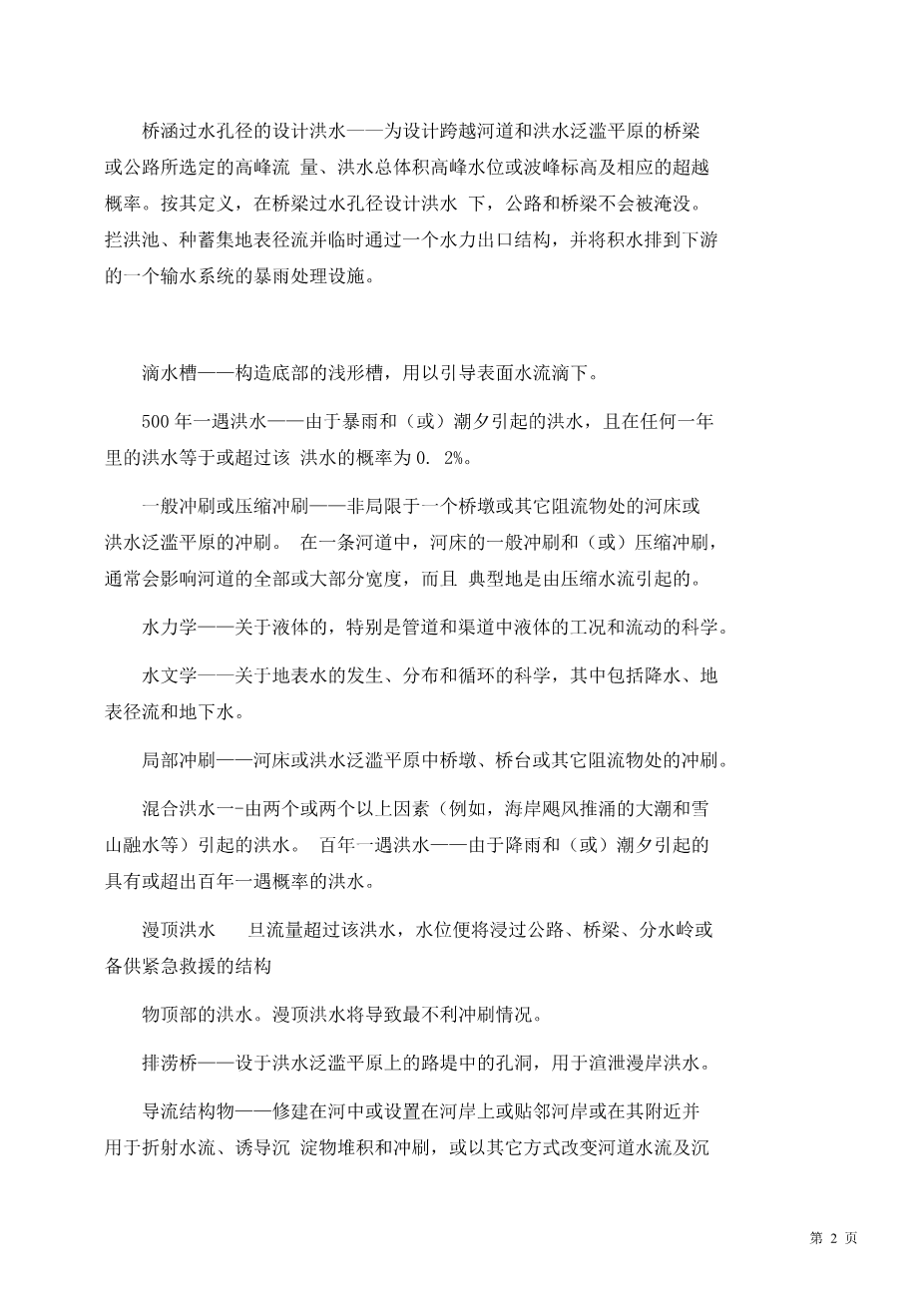Overall design and bridge location characteristics
2.1. Scope of use
This specification specifies the minimum requirements for bridge clearance, environmental protection, aesthetic geological survey, economy, driving comfort, durability, easy construction, easy inspection, easy maintenance, etc.The minimum requirements for traffic safety list the documents that should be handled with reference.At the same time, it also includes the minimum requirements for drainage facilities and self-protection measures for water, ice and salt in water.In view of the damage of many bridges caused by scouring, this regulation covers more details in hydrology and hydraulics.
2.2. Definition
Sedimentation-a comprehensive and progressive process in which the longitudinal section of the riverbed rises due to accumulation of sediment.
Check flood for bridge scouring-check flood refers to the flood exceeding the designed scouring flood flow rate due to storm, storm surge and tidal current, but does not include the flood exceeding the typical 500-year flood in any case.Bridge scour check flood level is used to check and evaluate the bridge foundation to determine whether it can withstand the flow of check flood without reservation and remain stable with the accompanying scour.
Clearance zone-a barrier-free and relatively flat area beyond the edge of the carriageway to ensure that out-of-control vehicles are controlled again.The above carriageway does not include shoulder and auxiliary lane.
Clear a barrier-free horizontal and vertical space.
Erosion-a comprehensive and progressive process of lowering the longitudinal section of the riverbed due to long-term erosion.
Design Flow-Provide the maximum water flow of a bridge that does not exceed the design constraints adopted.
The design flood-flood flow rate of bridge scour is equal to or less than the 100-year flood flow rate that can produce the deepest scour at the bridge foundation.Roads or bridges may be submerged under the flood.The worst-case scenario may occur under overtopping floods because the bridge holes have the potential danger of being pressurized drains.
Design flood of bridge culvert water-crossing aperture-the peak flow volume, total flood volume, peak water level or peak elevation and corresponding exceeding probability selected for designing bridges or highways crossing river courses and flood plains.According to its definition, roads and bridges will not be submerged under the design flood of the bridge water passing aperture.Rainstorm treatment facilities for flood storage ponds and seed banks to collect surface runoff and temporarily pass through a hydraulic outlet structure and discharge accumulated water to a water delivery system downstream.
Dropping tank-a shallow groove at the bottom is constructed to guide surface water to drip.
500-year flood-flood caused by rainstorm and/or tidal current, and the probability that the flood in any year is equal to or exceeds the flood is 0. 2%.
General scour or compression scour-not limited to scour of riverbed or flood plain at a pier or other obstruction.In a river course, the general scouring and/or compression scouring of the riverbed usually affects the whole or most of the width of the river course, and is typically caused by compressed water flow.
Hydraulics-Science concerning liquids, especially the working conditions and flow of liquids in pipelines and channels.
Hydrology-the science of occurrence, distribution and circulation of surface water, including precipitation, surface runoff and groundwater.
Local scour-scour at piers, abutments or other obstructions in riverbeds or flood plains.
Mixed Floods-Floods caused by two or more factors (e.g. tidal waves pushed by coastal hurricanes and snowy mountain melt water, etc.).Once-in-a-century flood-a flood that has or exceeds the probability of once-in-a-century due to rainfall and/or ebb and flow.
As soon as the flood discharge exceeds the flood, the water level will submerge roads, bridges, watersheds or structures ready for emergency rescue.
Floods on top of things.Overtopping flood will lead to the most unfavorable scouring condition.
Drainage Bridge-A hole in an embankment on a flood plain used to discharge floodwater.
Diversion structure-a structure built in or on the river bank or adjacent to or near the river bank and used to refract water flow, induce sediment accumulation and scouring, or otherwise change the river flow and sedimentation mechanism.
Drain outlet-water discharge facility through the bridge deck.
Barrier-free space for pedestrians only between sidewalk width guardrails or between guardrails and kerbs.
Spring tides (also known as syzygy tides)-the increasing tides that occur at full or new moons about every two weeks.
Stable riverbed-when the riverbed is at a certain longitudinal slope and cross section, so that the water flow and sediment from the upstream basin along with the water flow belt will not produce obvious riverbed erosion, sedimentation and riverbank erosion.
River topography-the science of the land form, general appearance and changes of the basin surface caused by erosion and erosion of sedimentary materials in rivers and flood-prone areas.
Superelevation-the slope on the road surface set on the horizontal curve for partially balancing the centrifugal force of the vehicle.
Extreme flood-flood or tidal current with a flow rate greater than once every 100 years but less than once every 500 years.
Tide-periodic rise and fall of the earths ocean plane caused by the action of the moon and the sun on the rotating earth.Watershed-the area defined by the watershed, which generally has only one drainage outlet and the surface runoff of the entire watershed is collected in one place.
River course-generally refers to
剩余内容已隐藏,支付完成后下载完整资料
英语译文共 17 页,剩余内容已隐藏,支付完成后下载完整资料
资料编号:[609396],资料为PDF文档或Word文档,PDF文档可免费转换为Word
课题毕业论文、外文翻译、任务书、文献综述、开题报告、程序设计、图纸设计等资料可联系客服协助查找。




